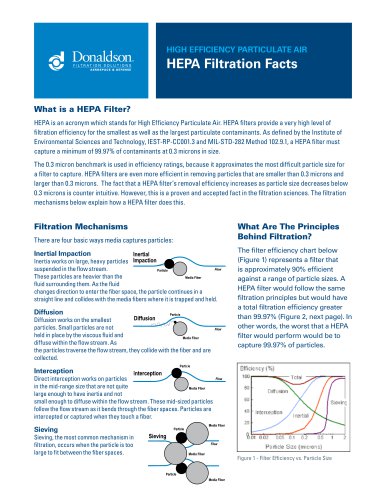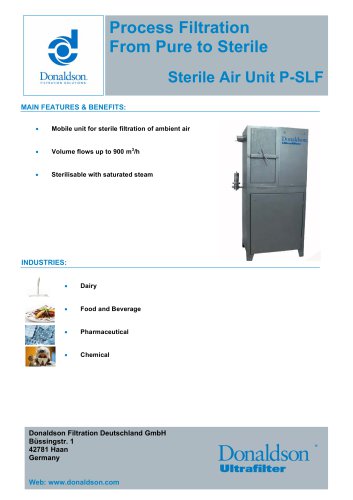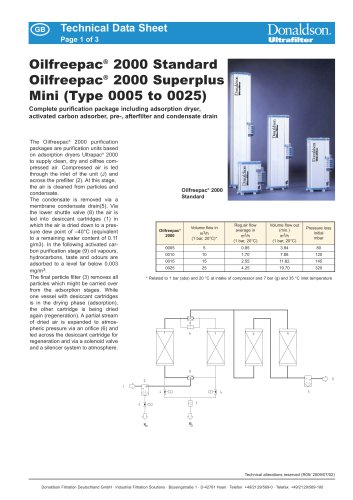
Catalog excerpts

FILTRATION SOLUTIONS HIGH EFFICIENCY PARTICULATE AIR What is a HEPA Filter? HEPA is an acronym which stands for High Efficiency Particulate Air. HEPA filters provide a very high level of filtration efficiency for the smallest as well as the largest particulate contaminants. As defined by the Institute of Environmental Sciences and Technology, IEST-RP-CC001.3 and MIL-STD-282 Method 102.9.1, a HEPA filter must capture a minimum of 99.97% of contaminants at 0.3 microns in size. The 0.3 micron benchmark is used in efficiency ratings, because it approximates the most difficult particle size for a filter to capture. HEPA filters are even more efficient in removing particles that are smaller than 0.3 microns and larger than 0.3 microns. The fact that a HEPA filter's removal efficiency increases as particle size decreases below 0.3 microns is counter intuitive. However, this is a proven and accepted fact in the filtration sciences. The filtration mechanisms below explain how a HEPA filter does this. Filtration Mechanisms There are four basic ways media captures particles: Inertial Impaction Inertial Inertia works on large, heavy particles Impaction suspended in the flow stream. These particles are heavier than the fluid surrounding them. As the fluid changes direction to enter the fiber space, the particle continues in a straight line and collides with the media fibers where it is trapped and held. Diffusion Diffusion works on the smallest particles. Small particles are not held in place by the viscous fluid and diffuse within the flow stream. As the particles traverse the flow stream, they collide with the fiber and are collected. What Are The Principles Behind Filtration? The filter efficiency chart below (Figure 1) represents a filter that is approximately 90% efficient against a range of particle sizes. A HEPA filter would follow the same filtration principles but would have a total filtration efficiency greater than 99.97% (Figure 2, next page). In other words, the worst that a HEPA filter would perform would be to capture 99.97% of particles. Interception Direct interception works on particles in the mid-range size that are not quite large enough to have inertia and not small enough to diffuse within the flow stream. These mid-sized particles follow the flow stream as it bends through the fiber spaces. Particles are intercepted or captured when they touch a fiber. Sieving Sieving, the most common mechanism in filtration, occurs when the particle is too large to fit between the fiber spaces.
Open the catalog to page 1
There’s No Such Thing as “True HEPA” The terminology of “True HEPA” is a loosely used marketing term. Various industries and institutions have different specifications as to how they define HEPA. For example the European Standard EN1822-1 defines a HEPA filter as ranging from 85% to 99.995% efficient against a 0.3 micron challenge. The standard adopted by commercial aircraft manufactures and many other industries is MIL-STD-282 Method 102.9.1 which requires the filter to capture 99.97% of 0.3 micron particles. Figure 2 illustrates how a HEPA filter, as defined by MILSTD-282 Method 102.9.1,...
Open the catalog to page 2All DONALDSON catalogs and technical brochures
-
UFK-L Aftercoolers
2 Pages
-
UFK-W Aftercoolers
3 Pages
-
P-EGS
3 Pages
-
CULINARY & PROCESS STEAM
8 Pages
-
Air Intake Systems
8 Pages
-
Clean DEF Solutions
4 Pages
-
Clean Fuel & Lubricant
32 Pages
-
Exhaust System Solutions
2 Pages
-
Pressure Control Systems
2 Pages
-
Innovative Fuel Systems
2 Pages
-
AEROSPACE & DEFENSE
4 Pages
-
pOWERCO RE® air cleaners
8 Pages
-
Donaldson Strata™ Tubes
4 Pages
-
PG-EG 0006 – 0192
6 Pages
-
(P)-GS N
6 Pages
-
Minerals Brochure
4 Pages
-
Metals Brochure
4 Pages
-
Industrial Filtration
10 Pages
-
Pharma Industry - Tetratex
2 Pages
-
Microfiltration
2 Pages
-
Power Generation
8 Pages
-
Vacuum Cleaner and Sweepers
4 Pages
-
Hydraulic Filtration
320 Pages
-
LDV FILTER KITS
4 Pages
-
Engine Liquid Filtration
154 Pages
-
Cabin Air Filtration
2 Pages
-
ToriT®powercore®dusT collecTors
16 Pages
-
PLEATED BAGS
3 Pages
-
DALAMATIC ® DUST COLLECTORS
12 Pages
-
HPK05
6 Pages
-
Engine Intake Systems
171 Pages
-
Ultrabev P-PF-BEV
4 Pages
-
Capsule Filters
8 Pages
-
Oilfreepac® 2000 Standard
3 Pages
-
Clean Fuel Cart X011407
1 Pages
-
Clean Fuel Cart X011408
1 Pages
-
Leakage Detector DLD
2 Pages
-
SG Standard Filter Housing
7 Pages
-
Bulk Oil Cleaniness Levels
1 Pages
-
Clean Fuel Cart X011431
1 Pages
-
Venting Product Overview
2 Pages
-
Vacuum Cleaners and Sweepers
4 Pages
-
Chemicals Brochure
4 Pages
-
DPF Thermal Regenerator IOM
16 Pages
-
Adsorbent Breather Assembly
2 Pages
-
Adsorbent Pouch Filter
2 Pages
-
Adsorbent Breather Filter
2 Pages
-
Bulk hP
4 Pages
-
ULTRAPOREX SB
2 Pages
-
LITHOGUARD®
2 Pages
-
BSMmax
2 Pages
-
Valves & Solenoids
2 Pages
-
DT filter
22 Pages
-
Off-Line Filtration
14 Pages
-
Sight Glasses
1 Pages
-
Strainers
4 Pages
-
Valves
6 Pages
-
Breathers
14 Pages
-
TT15/30/60
2 Pages
-
SP100/120
4 Pages
-
Low Pressure Filters
64 Pages
-
WL16
4 Pages
-
Medium Pressure Filters
38 Pages
-
W613
4 Pages
-
FPK02
6 Pages
-
HPK02
4 Pages
-
High Pressure Filters
86 Pages
-
panel filter
1 Pages
-
GDX
4 Pages
-
DISK DRIVE SEALS
2 Pages
-
ADSORBENT LABEL FILTER (ALF)
2 Pages
-
Hydraulic Filtration
374 Pages
-
Engine Liquid Filtration
132 Pages
-
Oil/Water Separators
6 Pages
-
SYNTEQ XP M/S
2 Pages
-
Synteq XP
4 Pages
-
Ultrac? AK
2 Pages
-
Ultrapoly? PE
2 Pages
-
ULTRAC A
2 Pages
-
Dryer Package Filters
2 Pages
-
SG Compressed Air Filters
2 Pages
-
AG Compressed Air Filters
2 Pages
-
Rotary Valves
10 Pages
-
Unimaster® Dust Collector
4 Pages
-
Unicell Dust Collectors
6 Pages
-
Downflo Dust Collectors
6 Pages
Archived catalogs
-
Sensor Vents
2 Pages
-
Fluid Analysis
12 Pages
-
Exhaust Product
186 Pages
















































































































































